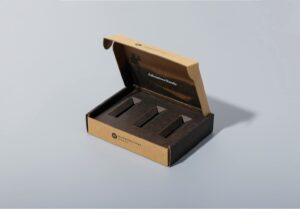Als eigenaar van een e-commercebedrijf wilt u uw producten veilig en stijlvol bezorgen om de loyaliteit van uw klanten te winnen. Maar waar begint u met e-commerceverpakkingen? Deze uitgebreide gids is ontworpen om u te helpen bij de basisprincipes en complexiteit van
e-commerce verpakkingen als beginner.
 1. E-commerceverpakkingen begrijpen
1. E-commerceverpakkingen begrijpen
E-commerceverpakkingen zijn het proces en de materialen die worden gebruikt om producten klaar te maken voor online verzending en levering. Hoewel het primaire doel is om het product tegen schade te beschermen, kan een goede verpakking ook de uitpakervaring van de consument verbeteren, het merkimago versterken en duurzaamheid bevorderen.
E-commerceverpakkingen bestaan doorgaans uit drie hoofdlagen: de productverpakking of primaire verpakking, de binnenverpakking voor extra bescherming en de buitenverpakking. Deze laatste is wat uw klant als eerste ziet en mee in aanraking komt, en vaak is dit het eerste fysieke contactmoment tussen uw merk en de klant. Daarom is het cruciaal om ervoor te zorgen dat het telt!
3. De basisprincipes van e-commerceverpakkingen
E-commerceverpakkingen dienen drie hoofddoelen: het beschermen van uw product, het beheersen van verzendkosten en het vestigen van uw merkidentiteit door in te spelen op de uitpakervaring van uw klant.
De eerste indruk is het belangrijkst. Hoewel het waar is dat klanten je product voor het eerst op hun computerscherm zien, is de eerste fysieke interactie doorslaggevend voor klantbehoud. De uitpakervaring is de échte eerste indruk van je merk.
De verwachtingen en verwachtingen van uw klanten worden bepaald door een eenvoudig digitaal beeld, maar uw bedrijf is verantwoordelijk voor het waarmaken of overtreffen van de verwachtingen van uw klanten. Hoe wordt dit bereikt?
Dat bereik je door je verpakking te kiezen op basis van het doel in plaats van de aantrekkingskracht. Met andere woorden: het gaat om wat erin zit.
De verantwoordelijkheid van de binnenverpakking is van het grootste belang: deze moet uw product beschermen tijdens de reis naar de klant. Er zijn verschillende beschermende verpakkingsmaterialen om te overwegen, waaronder noppenfolie, luchtkussens, schuimvullingen en biologisch afbreekbare verpakkingschips. De keuze voor de binnenverpakking hangt vaak af van de aard van het product.
Uw buitenverpakking bepaalt de eerste indruk die klanten van uw merk krijgen. Verzendzakken kunnen een kosteneffectieve en lichte oplossing zijn voor niet-kwetsbare artikelen, terwijl stevige dozen meer bescherming bieden voor kwetsbare of luxe producten. Vergeet niet dat uw keuze voor de buitenverpakking uw merk moet vertegenwoordigen, rekening houdend met de veiligheidseisen van uw product.
 6. Brandingmogelijkheden met e-commerceverpakkingen
6. Brandingmogelijkheden met e-commerceverpakkingen
E-commerceverpakkingen bieden talloze brandingmogelijkheden. Door uw verpakking te personaliseren met de kleuren, het logo en de slogan van uw merk, creëert u een onvergetelijke uitpakervaring voor uw klanten. Daarnaast kunt u bedankjes, kortingscodes voor toekomstige aankopen of zelfs kleine gratis extra's toevoegen, wat de merkloyaliteit verder bevordert en herhaalaankopen stimuleert.
Nu milieuvraagstukken steeds meer van invloed zijn op de aankoopbeslissingen van consumenten, is er een groeiende trend naar duurzame verpakkingen. Biologisch afbreekbare verpakkingsmaterialen, minimalistische verpakkingen en het stimuleren van recycling of hergebruik van verpakkingen kunnen het milieuvriendelijke imago van uw merk versterken.
Investeren in op maat gemaakte e-commerceverpakkingen kan de zichtbaarheid van uw merk vergroten en de klantervaring verbeteren. Dit kan leiden tot klantloyaliteit en een hogere omzet.
Houd rekening met de grootte, vorm, het gewicht en de kwetsbaarheid van uw producten. Raadpleeg indien nodig verpakkingsdeskundigen om ervoor te zorgen dat uw producten tijdens het transport worden beschermd.
3. Kan ik de kleuren en het logo van mijn merk in mijn verpakking verwerken?
Ja, en het is een echte aanrader. Merkverpakkingen vergroten de naamsbekendheid en herkenning.
Enkele voorbeelden zijn gerecycled karton, biologisch afbreekbare vulmiddelen zoals verpakkingschips van maïzena en biologisch afbreekbare verzendzakken.
Een efficiënt verpakkingsontwerp kan het gebruik van onnodige materialen verminderen en zo de verpakkingskosten verlagen.
Navigeren door het landschap van e-commerceverpakkingen kan lastig lijken, maar zodra je de basis begrijpt, zijn de mogelijkheden enorm. Een strategisch en goed gepland e-commerceverpakkingssysteem kan een gewone levering transformeren tot een inspirerende merkervaring, terwijl het tegelijkertijd productveiligheid en ecologische verantwoordelijkheid hoog in het vaandel draagt. Door je verpakkingsproces te optimaliseren en te personaliseren, kun je een onvergetelijke uitpakervaring creëren en het succes van je merk een boost geven.
 1. E-commerceverpakkingen begrijpen
1. E-commerceverpakkingen begrijpen
 6. Brandingmogelijkheden met e-commerceverpakkingen
6. Brandingmogelijkheden met e-commerceverpakkingen